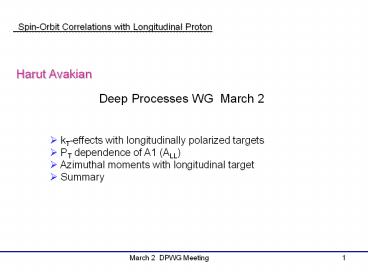Describe the complex nucleon structure in terms of partoni PowerPoint PPT Presentation
Title: Describe the complex nucleon structure in terms of partoni
1
Spin-Orbit Correlations with Longitudinal Proton
Harut Avakian
Deep Processes WG March 2
- kT-effects with longitudinally polarized targets
- PT dependence of A1 (ALL)
- Azimuthal moments with longitudinal target
- Summary
2
Physics Motivation
Describe the complex nucleon structure in terms
of partonic degrees of freedom of QCD
QCD evolution tells us how parton distributions
evolve, but not original distributions
J q
Understanding of the orbital motion of quarks and
spin-orbit correlations is crucial!!!
3
SIDIS kinematical plane and observables
Trento Conventions
Phys.Rev. D70, 117504 (2004).
U unpolarized L long.polarized T trans.polarized
Target polarization
sin2f moment of the cross section for unpolarized
beam and longitudinal target
4
kT-dependent SIDIS
p- PT z k- O(k-2/Q2)
Anselmino et al (Phys.Rev D71,074006 (2005)
produced pion
initial quark
data fit on Cahn effect ?m020.25GeV2,mD20.2GeV2
scattered quark
EMC (1987) and Fermilab (1993) data (assuming m0u
m0d)
Precision measurements of azimuthal moments
required to study kinematic and flavor
dependences (m0u and m0d) of transverse momentum
distributions of quarks
5
Transverse momentum of quarks
Mulders Tangerman (1995, the TMD bible)
quark polarization
- kT required to describe azimuthal distributions
of hadrons and in - particular SSAs.
- kT - important for cross section description
(also for exclusive production) - kT leads to 3D description with 8PDFs
proton polarization
6
A1-PT-dependence
initial quark
hep-ph/0608048 m020.25GeV2 mD20.2GeV2
scattered quark
PT-dependence of double spin asymmetries provide
access to difference in
kT-distributions of quarks with spin orientations
along and opposite to the proton spin.
7
cosf moment in A1-PT-dependence
hep-ph/0608048 m020.25GeV2 mD20.2GeV2
PT-dependence of cosf moment of double spin
asymmetry is most sensitive to kT-distributions
of quarks with spin orientations along and
opposite to the proton spin.
8
kT-dependence and parameterizations of PDFs
BBS (NP B441, 197 (1995) using helicity
structure of perturbative QCD coupling at x?1
Measure kT dependence of f1/-g1 in polarized
SIDIS
nminimal number of spectator quarks 2
9
PDFs and orbital momentum
Brodsky If Lz?0 then the LFWF vanishes at zero
kT and the momentum distribution tends to be
pushed out to large kT
Transverse position shift using GPD-E
Good agreement of HERMES (filled circles) and
JLab (open) data with BBS curves for quarks
aligned with proton spin, where the orbital
motion is not as important.
10
Collins fragmentation Longitudinally polarized
target
(sTkT)(pSL)? h1L
Kotzinian-Mulders Asymmetry
y
PT
sT
fC
sUL
KM
fh
fSfh
fS
sin(fC) sin(2fh)
curves, cQSM from Efremov et al
- Measure the twist-2 Mulders TMD (real part of
interference of L0 and L1 wave functions) - Study the Collins asymmetry with longitudinally
polarized target will provide independent
information on the Collins function.
11
Summary
- The pT dependence measured for the first time
for A1 and its cosf moment. - Significant target spin dependent sin2f moment
measured for the first time with longitudinally
polarized target - CLAS double polarized data at large x indicate
significant effects from spin-orbit correlations - A draft version of the paper and the analysis
note will be available during March (waiting a
cross check)
12
support slides
13
CLAS12 Mulders TMD projections
Simultaneous measurement of, exclusive r,r,w
with a longitudinally polarized target important
to control the background.
14
Azimuthal moments in SIDIS (1/Q2)
15
CLAS Transversely Polarized Target
16
Extracting h1 and h1L from p AUT and AUL
For Collins fragmentation use chirally invariant
Manohar-Georgi model (Bacchetta et
al) Distribution functions from cQSM from Efremov
et al
Systematic error from unknown ratio of favored
and un favored Collins functions (R
H1d?p/H1u?p), band correspond to -2.5ltRlt0
p- and p0 SSA will give access to h1d/h1Lu ( If R
-1 neutron data could be used)

